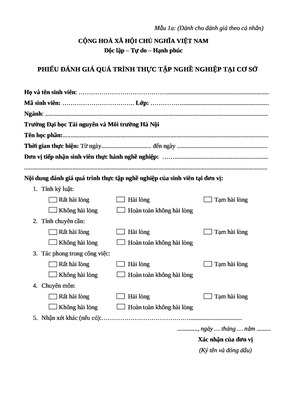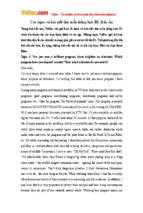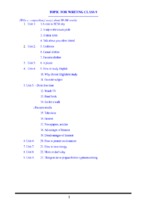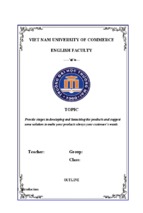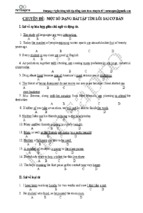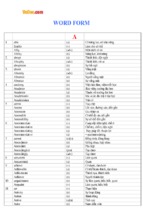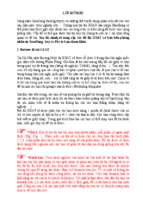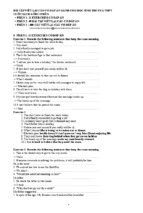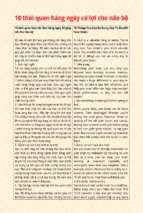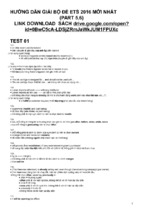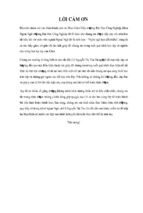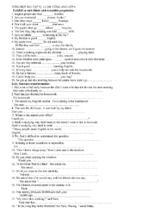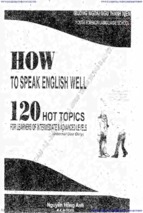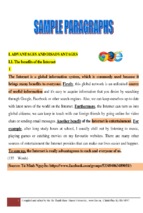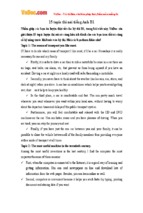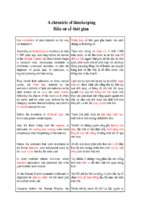The task of writing, that is, of producing
a written document of some description –
is like many other tasks: what we tend to
think of as the whole is in fact only a part.
If the talk of tasks and burdens suggests
that writing is all labor and no reward,
then let it be said that there is as much
satisfaction and pleasure to be gained
THE FACTS ON FILE
GUIDE TO
GOOD WRITING
The task of writing, that is, of producing a written
document of some description – is like many other
tasks: what we tend to think of as the whole is in fact
only a part. If the talk of tasks and burdens suggests
that writing is all labor and no reward, then let it be
said that there is as much satisfaction and pleasure to
be gained from writing as from the exercise of any
other skill. The task of writing, that is, of producing a
THE FACTS ON FILE
GUIDE TO
GOOD WRITING
MARTIN H. MANSER
DAVID H. PICKERING and STEPHEN CURTIS
Associate Editors
THE FACTS ON FILE GUIDE TO GOOD WRITING
Copyright © 2006 by Martin H. Manser
All rights reserved. No part of this book may be reproduced or utilized in
any form or by any means, electronic or mechanical, including photocopying,
recording, or by any information storage or retrieval systems, without permission
in writing from the publisher. For information contact:
Facts On File, Inc.
An imprint of Infobase Publishing
132 West 31st Street
New York NY 10001
Library of Congress Cataloging-in-Publication Data
Manser, Martin H.
The Facts On File guide to good writing / Martin H. Manser.
p. cm.
Includes index.
ISBN 0-8160-5526-2 (acid-free paper)
1. English language—Composition and exercises—Study and teaching
(Elementary) 2. English language—Grammar—Study and teaching (Elementary)
I. Title: Guide to good writing. II. Title.
LB1576.M3775 2005
372.62'3—dc22
2004026990
Facts On File Books are available at special discounts when purchased in bulk
quantities for businesses, associations, institutions or sales promotions. Please
call our Special Sales Department in New York at (212) 967-8800 or
(800) 322-8755.
You can find Facts On File on the World Wide Web at
http://www.factsonfile.com
Text design by Erika K. Arroyo
Cover design by Cathy Rincon
Printed in the United States of America
VB FOF 10 9 8 7 6 5 4 3 2 1
This book is printed on acid-free paper.
CONTENTS
Introduction
ix
PART I THE WRITING PROCESS
✒
✒
Introduction
The Four Stages of the Writing Process
1 Preparing to Write
✒ Thinking and Researching
✒ Paraphrasing and Summarizing
✒ Quotations
✒ Thinking and Researching: An Overview
✒ Planning
✒ Planning: An Overview
2 Writing Your Document
✒ Getting Started
✒ Your Authorial Voice
✒ Composition: Paragraphs
✒ Writing: An Overview
3 Revising Your Document
✒ How to Revise
✒ Revision Checklist
✒ An Example of Revising a Text
✒ Checking for Consistency
✒ Proofreading
✒ References
✒ Revision: An Overview
3
4
7
7
22
29
36
36
47
48
48
54
63
71
72
72
74
75
86
88
89
92
PART II WRITING FUNDAMENTALS
✒
Introduction
4 Grammar
✒
✒
✒
✒
✒
✒
✒
✒
✒
✒
✒
Introduction
Nouns
Adjectives
Determiners
Verbs
Adverbs
Pronouns
Prepositions
Conjunctions
Phrases, Clauses, and Sentences
Reporting Speech
5 Words in Use
✒
✒
✒
✒
✒
✒
✒
✒
✒
Introduction
Vocabulary
Spelling
Prefixes and Suffixes
Foreign Words and Phrases
Abbreviations and Symbols
Numbers
Sensitive Terms
Slang
95
97
97
98
109
114
115
132
135
141
144
148
167
171
171
171
176
185
193
202
217
219
227
6 Words Often Confused
229
7 Punctuation
337
✒
✒
✒
✒
✒
✒
✒
✒
✒
✒
✒
✒
Introduction
Punctuation Marks
Apostrophe
Capital Letters
Colon
Comma
Dash
Ellipsis
Exclamation Point
Hyphen
Italics
Paragraph
337
338
338
340
340
342
347
348
349
350
352
353
✒
✒
✒
✒
✒
✒
Parentheses and Brackets
Period
Question Mark
Quotation Marks
Semicolon
Slash
8 Reference Resources
✒
✒
✒
✒
✒
Introduction
Dictionaries
Thesauri
Other Reference Books
Electronic Reference Sources
9 Glossary of Grammatical Terms
Index
353
354
355
356
358
359
360
360
360
361
362
363
365
383
INTRODUCTION
E
verywhere in the modern world the emphasis is on speed, and nowhere
have things moved faster than in communications. Messages travel at
the speed of light, and we humans seem to feel that we have to imitate the
wonderful machines that flash our words around the globe in fractions of
a second. We have become a race of scribblers, jotting memos, punching in
text messages, rushing off e-mails, and dashing off quick “Happy Birthday”
or “Thank You” cards, often not worrying much whether what we write
gets our message across or even makes sense. Fewer and fewer of us, it
seems, take the time to write properly. Fewer and fewer of us perhaps
know how to write properly. Fashions in the teaching of English have
changed over the years, and we can easily find that we have finished our
education but have never grasped the principles of correct English. Then
the day comes when we have to write an important letter, prepare a speech
or presentation, or hand in an essay or assignment, and suddenly we are at
a loss.
Are you unsure about how to write good, clear English? If you are, this
book has been specifically designed to help you. It comes in two major sections: Chapters 1 to 3, of Part I, deal with the writing process itself; chapters
4 to 9, which make up Part II, deal with grammar, spelling, usage, and punctuation. Some writing manuals begin with grammar and then move on to discuss writing. The authors of this book believe, however, that it is better to get
something down on paper in draft form first and to polish up the grammar
afterward, hence the placement of the “Preparing to Write,” “Writing Your
Document,” and “Revising Your Document” chapters at the beginning.
These chapters treat writing as a task that can be divided into manageable
parts: thinking, researching, and planning; writing; and revising. Each of
these activities is explained in detail with the help of examples.
In order to write good English, however, we also need to be aware of the
rules that govern the use of words and the construction of sentences. The
later chapters therefore contain a review of grammar, a discussion of how
words are formed and used in practice, advice on sensitive language issues, a
list of words that are often confused (“Is it continual or continuous?”), and
ix
x THE FACTS ON FILE GUIDE TO GOOD WRITING
a guide to punctuation (“Where do I put a comma?”). The book concludes
with information about additional reference tools to help with problems of
grammar and vocabulary and a glossary of grammatical terms.
There are two ways of finding what you need within the pages of this
book. If you want help with a general topic (for example, planning, summarizing, verbs, spelling, or commas), you can find your way to the relevant section either through the Table of Contents or the Index. If you are unsure
about how to use a particular word, for example, whether you should use
affect or effect, then you can look up either of these words in the Index,
where you will be directed to the page where the usage of the word or words
in question is discussed.
So, if you are faced with a particular task, such as writing a formal letter, a report, or an assignment, then you will find help here. If you need to
develop your understanding of the basic rules of English grammar, punctuation, spelling, or usage, all the information and guidance you need is provided. The authors hope that you will find this book a useful, practical—and
at times perhaps even inspiring—guide to writing good English.
Martin H. Manser
David H. Pickering
Stephen Curtis
Part I
THE WRITING PROCESS
INTRODUCTION
The purpose of this section is to guide you through the process of producing
a written document that will say what you want it to say and achieve the purpose that you want it to achieve.
This book starts from the assumption that writing belongs in the category of basic tasks—that it is on a similar level to, say, cooking or driving.
Just as most people ought to be able to drive a car or cook an egg, because
ordinary living is a lot more complicated if they cannot perform these simple
tasks for themselves, so most people ought to take the time to acquire the
rudiments of writing. There are, of course, people who are born with a natural talent for writing and people who write for a living. When we call someone “a writer,” we usually mean that he or she is a journalist or an author.
But there are a great many people, too, who are natural-born cooks or who
earn their daily bread baking bread for others, and there are just as many
who support their families by driving trucks, limousines, or even racing cars.
The existence of experts and professionals does not exempt the rest of us
from learning the basic skills that they have developed to a particularly high
degree. This is as true of writing as it is of any similar activity. Writing skills
can be learned. There are well-established procedures that can be followed
when you are preparing or composing a document. This part of the book will
familiarize you with those skills and procedures and help you to undertake
this basic process with more than merely basic equipment.
When we analyze any process from beginning to end, breaking it down
into its different stages and discussing each of those stages in some detail, the
analysis is likely to make the process seem more extended and elaborate than
it generally is in real life. That does not mean that the process is in itself especially complicated, mysterious, or intimidating. Explaining even the most
basic task usually takes longer than actually performing it.
Furthermore, not all the procedures outlined in the following pages will
be relevant to every writing task you face. Common sense will tell you—if the
clock and your schedule do not—how much time and effort you should
expend on a particular writing task. Common sense will likewise tell you
which procedures are relevant to even the most minor compositional duties
and which will be most useful to you personally. Your own habits, strengths,
and weaknesses will probably make you want to concentrate on some aspects
of the writing process more than others. Everything dealt with in this section
of the book, however, is worth looking into for the day when you are suddenly confronted with the job of composing that vital letter, report, or assignment that presents far more of a challenge to your authorial know-how than
an everyday memo or set of notes. It is worth considering the writing process
as a whole, in case you can pick up any tips that will lighten your particular
3
4 THE FACTS ON FILE GUIDE TO GOOD WRITING
burden, or in case something stated here points out a bad writing habit that
could be replaced by a better one.
If the talk of tasks and burdens suggests that writing is all labor and no
reward, then let it be said that there is as much satisfaction and pleasure to
be gained from writing as from the exercise of any other skill. Cooks who
produce perfect omelets or drivers who take hairpin turns smoothly and without unnerving their passengers have a right to feel pleased with themselves.
So do people who write well. And their efforts are just as likely to be appreciated.
THE FOUR STAGES OF THE WRITING PROCESS
The task of writing is like many other tasks: What we tend to think of as the
whole is in fact only a part. Just as building a wall involves more than laying
bricks in rows and cementing them together with mortar, so writing involves
more than filling a screen or a sheet of paper with words. That is the main
part, the crucial part, perhaps, but we neglect the other parts at our peril.
As with so many other jobs, the before and the after in writing are as
important as the central act. An old saying states that composition is 10 percent inspiration and 90 percent perspiration. This is distressingly true, but
there are more useful and relevant ways of working out the percentages. The
average writing task can be broken down roughly as follows: 50 percent
preparation, 25 percent creation, and 25 percent revision. On that basis, we
may even have to change our view of what constitutes the main part of the
task.
However small the job, time spent thinking, planning, and researching
before you sit down at your desk to begin your text is anything but wasted
time. The better prepared you are, the easier it will be to find the right words
to put across your point. This is an obvious fact, but so often disregarded.
Likewise, when you write “The end” for the first time or come to the point
where you would normally add your signature, the task is still not finished.
Since Greek and Roman times, experienced creative writers have urged their
disciples to “polish”—that is, to revise and perfect—everything they write.
“Polissez-le sans cesse, et le repolissez,” said the French classical poet Nicolas Boileau. We might freely translate his advice as “Polish your work nonstop, and then sit right down and polish it again.” Even if you are not aiming
at classical perfection, you will need to look over your work carefully and
revise it. Word-processing spell-check programs only check your spelling;
they do not edit your work. They cannot tell you that your work would benefit from a little shortening here and a little filling out there. If you can persuade a candid (and literate) friend to look over what you have written, so
much the better, because fresh eyes often spot what familiarized eyes slide
over. But even if you have such a friend, and he or she has time available, the
final responsibility is yours. It would be a pity if the 75 percent (of preparation and creation) were spoiled because you omitted to pay sufficient attention to the final 25 percent (revision).
In a nutshell, then, the four stages of the writing process are
•
•
Thinking and researching
Planning
INTRODUCTION
•
•
5
Writing
Revising
These four stages do not always separate so neatly in practice. While you are
thinking, researching, or planning, a way of formulating a point may occur
to you, and instead of writing a note, you may find yourself writing a paragraph that you will incorporate, unchanged, into your final version. Many
people revise as they go along or find that they have to get a particular section just right before they can continue confidently with the rest of a piece of
work. Some people are terrified by a blank screen or a blank piece of paper
and have to be fully prepared before they can make the first stroke. Other
people are deterred not by the blankness of a screen or paper but by a mental blankness that afflicts them if they try to think about a task in the abstract.
Such people may need to start writing before they can start thinking. Common sense and experience will soon show you what works best for you.
There is no substitute, in the end, for learning by doing. This book calls itself
a Guide to Good Writing, and you should use this section as a guide rather
than as an inflexible set of rules.
The order presented above, however, is the logical order—the order in
which an organized person would set about the task. And the more organized
you are, the better, especially if you are facing a deadline. Allow yourself as
much time as you can, and divide the time you have appropriately, remembering especially to leave yourself sufficient time to revise and correct your
work at the end. In the next three chapters, we will look at these four stages
in more detail.
1
term paper, or
written project
depends not
only on the
Preparing to Write
THINKING AND RESEARCHING
The writing process starts in your head. It may seem a little pedantic to elevate thinking into a separate stage of the process, but how can you start writing until you know what you want to write? Besides, the great advantage of
writing as a means of communication is that you have time to consider carefully what you are going to communicate. When you communicate in conversation, generally speaking, you have to make things up as you go along.
There are several disadvantages to writing something as opposed to saying it,
and we shall consider these later, but one distinct advantage is you do not
have to put down on paper the first thing that comes to mind. Use that advantage. Remember also that the first virtue in writing of any kind is clarity.
Clear writing comes first and foremost from clear thinking.
Thinking
There are three questions that you have to think about. You must answer
these for yourself before you go any further.
•
•
•
What kind of document am I writing?
What am I writing about?
Whom am I writing to or for?
The nature of the piece of work you have in hand—school assignment, letter, report—will affect the way you style what you write. The status of the
reader you have in mind—instructor, friend, child, boss—will also partly
determine the style you choose. The nature of the text and the identity of the
reader also have a bearing on the type of information that you put into your
writing and may have to be assembled beforehand. Statistics may be useful
for some purposes, for example. Detailed descriptions of objects, scenes, or
processes may be required. You may be expected to quote from literary or
scientific works, and if you use quotations, then you will also be expected to
provide some kind of referencing system. The clearer you are about the kind
of task you are engaged in, the easier it will be to prepare for it and accomplish it.
In many instances somebody else will have set you a particular writing
task. If so, this person will probably have defined the task for you. In many
cases, however, you will be writing on your own initiative, so you must define
7
8 THE FACTS ON FILE GUIDE TO GOOD WRITING
the task for yourself. Consider carefully the three questions listed above.
When you have found answers to them, you should be in a position to produce a concise statement of what you intend to do, what we might call,
adopting business terminology, a “mission statement.”
THE TASK DEFINED: THE MISSION STATEMENT
Your “mission statement” should be no more than a brief note that sums up
your purpose in writing. Whether you write it down or keep it in your head
will depend on your personal preferences and your power of memory, but it
is generally safer to jot down thoughts and ideas and have them as a visual
aid. For example,
Talk to be given to members of Ultraville Rotary Club on
chairman and treasurer’s visit to Rotary Club of Infraham,
VA, and arrangements for return visit of Infraham R.C. officers
or,
Short story for Ladyfriend magazine based on incident at
bowling alley last Saturday night: main character, Lucia,
40s, 3 kids, meets younger man
or,
Brief explanatory statement for department colleagues about
reasons for opposing proposed relocation from downtown
premises to new greenfield site
Your mission statement is for your eyes only. So long as it is clear to you
what kind of piece you intend to produce, what it is about, and what kind of
readership you are targeting, it does not matter at this stage if an outsider
would understand it or not. For example, you know what happened at the
bowling alley and what kind of person Lucia is; the rest of the world will find
out in due course.
The purpose of the mission statement, whether mental or written down,
is twofold. First, it provides you with your initial impetus: You have defined
your task, so now you can set about doing it. Second, as you proceed, or
when you reach the end, it enables you to check that you are doing, or have
done, what you set out to do. Once you have established the basic nature of
your undertaking, it is time to begin assembling your material.
MORE THINKING
Everything you write—whatever it is, whatever it is about, whomever it is
intended for—should contain something that comes uniquely and individually
from you. If you are intending to write something fairly brief, there is a good
chance that your own knowledge, experiences, and ideas will provide you all
the material that you need. You simply have to set your memory to work and
PREPARING TO WRITE
9
use your reason and your imagination to put the material into a proper order.
The document will, as a consequence, bear your personal stamp.
Even if your task is to write something more extensive, and even if you
realize from the outset that your existing personal resources will not be sufficient to provide everything you require, your personal input in the form of
your individual approach to the topic is still going to be the freshest and most
valuable element in the piece. If you are starting from scratch and have undertaken to write on a subject you know little or nothing about, you will need
to establish a connection with that subject or else your work will be very
heavy going, both for you and for your reader. Whatever the situation, therefore, in order to supply the vital personal touch you will need to do some creative thinking before you begin any research.
The process of creative thinking is not easy to describe and cannot really
be done to order. At this point you will have to use up some of your allotted
10 percent of inspiration. A certain amount of free association is called for.
What does the topic mean to you? What sort of ideas or images does it call
up for you? What do you immediately and naturally connect with it? If someone said X to you, what would your first thought or your first reaction be?
Remember, too, that ideas do not have to come in the form of statements. If they come in the form of questions, they can be equally, if not more,
useful. List the basic question words—who, why, how, what, when, where,
and which—and apply them to your topic. If you know little or nothing
about a subject, ask yourself what you would like to know. If you are already
familiar with it, ask yourself what it is that particularly interests you. Consider why something happened, or if the time and place at which it happened
were significant. Think whether you know precisely how something happened or how something is done, and whether it is worth finding out. Do not
be afraid to ask yourself apparently obvious or stupid questions. The
answers may be less obvious, self-evident, or irrelevant than you think. In
posing these questions you may come across an entirely new angle on the
subject that nobody else has thought of because the answer was assumed to
be a foregone conclusion. Why did the dog not bark in the night? wondered
Sherlock Holmes, and the answer provided the key to the mystery. Why are
there subtle differences between the finches on the various islands in the
Galapagos? asked Charles Darwin; working out the answer was a milestone
in the development of his theory of evolution. How many children had Lady
Macbeth? queried the literary critic F. R. Leavis, not intending to throw new
light on the play so much as to deride a previous school of critics whose
method was to treat Shakespeare’s characters as if they were real people. Any
student of Macbeth might nevertheless find it interesting to consider Leavis’s
“stupid” question, for Lady Macbeth says, “I have given suck and know /
How tender ’tis to love the babe that milks me,” yet in the play there is no
sign that children feature in the home life of the Macbeths. Does this tell us
something about the characters and situation of the Macbeth couple, or is it
an inconsistency on Shakespeare’s part that tells us more about his priorities
when devising a play? Wrestling with—or simply letting your mind play
with—questions such as these can often arouse your interest and set your creativity to work.
In order to illustrate this stage of proceedings, let us now turn to a concrete example. Let us assume that you have been asked, or have decided, to
- Xem thêm -

